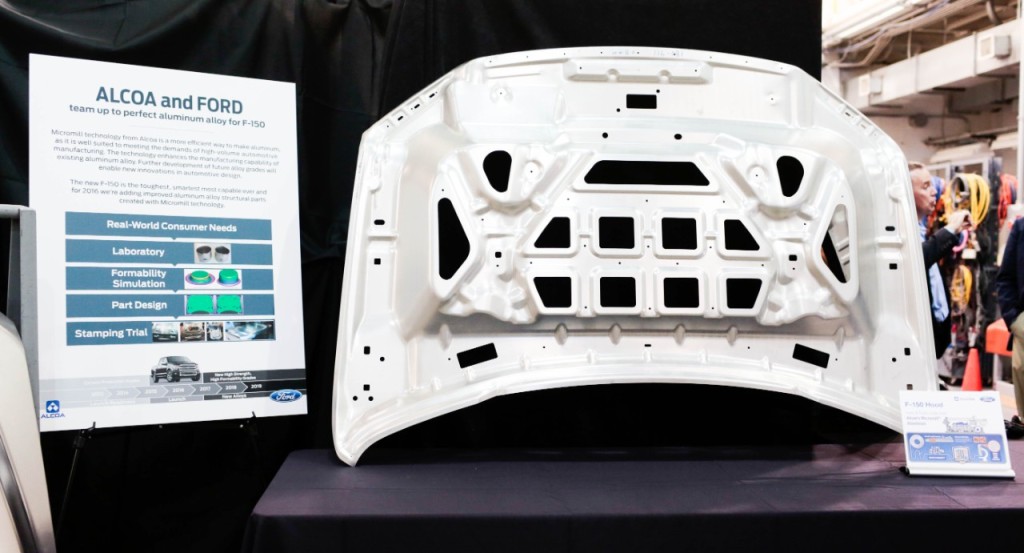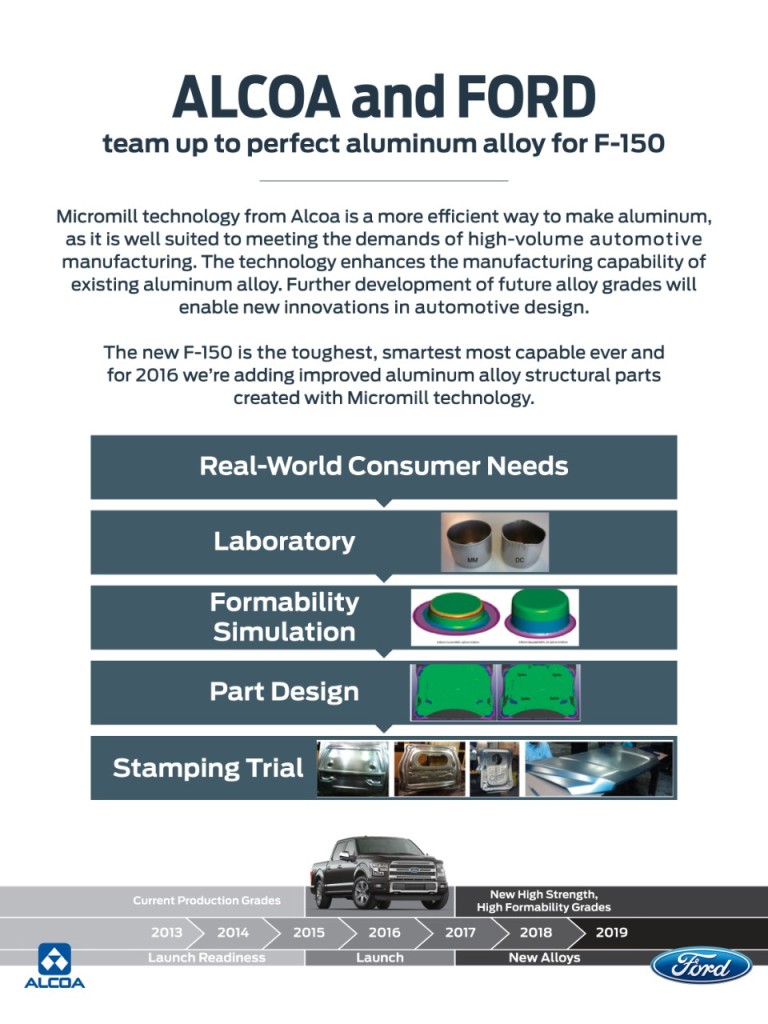
Ford to use ‘design-friendly’ Alcoa Micromill aluminum on 2016 F-150
By onMarket Trends | Repair Operations | Technology
Ford announced Monday it will become the first automaker to use Alcoa’s Micromill aluminum by incorporating the strong but “design-friendly” alloy into the 2016 F-150.
Alcoa said in December 2014 that Micromill alloys are as strong as high-strength steel but as malleable as mild steel. They’re also 40 percent more formable and 30 percent stronger than traditional aluminum, the metals giant said in a December news release, “enabling the production of automotive sheet that is thinner and even lighter than previous generations.”
“Alcoa’s breakthrough Micromill technology offers highly differentiated automotive material with strength, weight, formability and surface quality combinations previously impossible,” Alcoa Chairman and CEO Klaus Kleinfeld said in a statement Monday. “This high-tech aluminum will give Ford a true material edge enabling greater design flexibility and better vehicle performance – making the concept cars of tomorrow a reality.”
Ford said the Micromill malleability is ideal for complex shapes, which are difficult to produce through traditional means without joining several pieces together. With Micromill, you can make the entire component as a single strong part.
Learn more about OEMs, aluminum, steel at SEMA Repairer Driven Education
Those wanting to learn more about what the automakers will be throwing at your shop in the future should attend the special OEM Collision Repair Technology Summit at the SEMA Show as part of the Society of Collision Repair Specialists’ Repairer Driven Education Series. The sessions include “Advanced Automotive Technology,” “The Future of Aluminum in the Automotive Industry” and “The Continuing Evolution of Advanced Steels in Automotive Bodies.” There’ll be a heavy emphasis on joining, lightweight materials and the scans necessary to make sure all the new tech works. Register here.
Alcoa in December cited door inner panels and outer fenders as potential candidates for the technology, though Ford also hinted that “critical strength structural parts” could use Micromill as well.
“The door inner is one of the most difficult parts in automotive stamping,” Ford structures and stamping global manager Peter Friedman said in a statement. “The ability to produce an alloy using Alcoa’s Micromill technology to make that part is a real statement for how this process can benefit the automotive industry and Ford in particular.”
The Micromill aluminum will first appear in 2016 F-150 manufacturing in the fourth quarter of 2015, and Ford projects it will “more than double” Micromill content from 2016 to 2017.
“Light-weighting enables us to design vehicles with great customer attributes – like the F-150, which can tow more, haul more, accelerate quicker and stop faster than the previous F-150, and is more fuel-efficient than ever,” Ford Vice President Raj Nair said in a statement. “This collaboration supports our continued drive for innovation, as we research automotive applications for even greater light-weighting.”
Alcoa indicated Micromill could help lower aluminum costs — a key factor in boosting adoption of the metal. The company called the technology the “fastest, most productive aluminum casting and rolling system in the world.”
“A traditional rolling mill takes around 20 days to turn molten metal into coil, Micromill does it in just 20 minutes,” Alcoa continued.
Not only is it fast, it’s efficient. Alcoa says a Micromill is 25 percent of the size of a regular aluminum rolling mill — and energy use drops 50 perent.
This could be an interesting challenge for aftermarket manufacturers who can’t get their hands on Micromill aluminum. It’d be difficult to say a part is truly “like kind and quality” if it isn’t as light and strong as Micromill aluminum and made in “one take” instead of by assembling several pieces.
Another benefit — Ford might start citing “Micromill” left and right instead of repeating “military grade” every 5 seconds. We could use a break.
More information:
“FORD, ALCOA COLLABORATE ON MORE FORMABLE AND DESIGN-FRIENDLY NEXT-GENERATION ALUMINUM ALLOYS”
Ford, Sept. 14, 2015
“Alcoa Unveils Next-Generation Aluminum Materials Through Breakthrough Manufacturing Technology”
Alcoa, Dec. 14, 2014
Images:
Ford announced Monday it will become the first automaker to use Alcoa’s Micromill aluminum by incorporating the strong but “design-friendly” alloy into the 2016 F-150. Pictured here are Ford Vice President and global product development chief technical officer Raj Nair, left, and Alcoa Chairman and CEO Klaus Kleinfeld. (Provided by Ford)
Alcoa said in December 2014 that Micromill automotive alloys — an example of which is seen here — are as strong as high-strength steel but as malleable as mild steel. (Provided by Ford)
A flyer touting the applications of Micromill aluminum is shown. (Provided by Ford)


